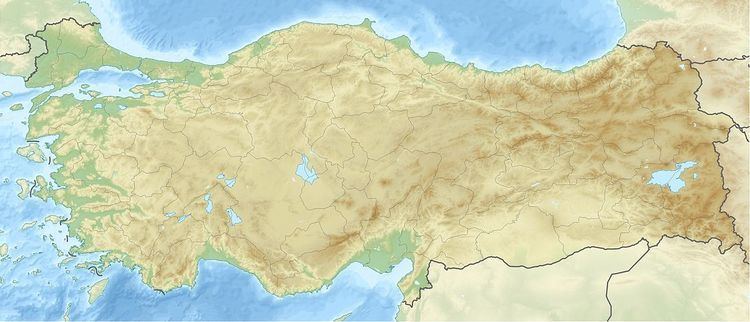Country Turkey Opening date 2012 Type of dam Concrete gravity Opened 2012 Surface area 65.4 km² Construction began 2008 | Status Operational Height 195 m Catchment area 64,724 km² Construction cost 1.2 billion USD | |
 | ||
Location | ||
The Boyabat Dam is a concrete gravity dam on the Kızılırmak River bordering Sinop and Samsun Provinces, Turkey. It is 8 km (5 mi) southwest of Durağan and 24 km (15 mi) southeast of Boyabat. Construction began in 2008 and the dam and power plant were completed in December 2012. Its primary purpose is to generate hydroelectric power. The dam's power plant has an installed capacity of 513 MW.
Contents
- Map of Boyabat Dam 57700 YenikC3B6y KC3B6yC3BC2FDuraC49Fan2FSinop Province Turkey
- Erke group locatelli cranes works at boyabat dam project
- BackgroundEdit
- Design and operationEdit
- References
Map of Boyabat Dam, 57700 Yenik%C3%B6y K%C3%B6y%C3%BC%2FDura%C4%9Fan%2FSinop Province, Turkey
Erke group locatelli cranes works at boyabat dam project
BackgroundEdit
Plans for the dam first began in 1958 when the Electrical Works Survey Administration studied the river for hydropower potential. By 1979, Turkey's State Hydraulic Works (DSI) and Japan's Electric Power Development Company completed feasibility studies. A final study and proposal was completed soon after. In 1986, DSI began preliminary works which included access roads and the diversion tunnels. Doğuş Holding was awarded the dam's tender on 18 September 1995. They signed a concession with Turkey's Ministry of Energy and Natural Resources on 22 October 1998. However, a license to operate the power plant was not awarded until 14 November 2007. Five Turkish banks had to fund US$750 million of the dam's US$1.2 billion price tag. The consortium owning the dam became Boyabat Elektrik. Construction on the dam began in April 2008, was delayed and restarted January 2012. The dam and power plant were accepted on 3 December 2012 and inaugurated nine days later.
Design and operationEdit
Built in a steep gorge of the Ilgaz mountains, the concrete gravity dam is 195 m (640 ft) tall and 262 m (860 ft) long. Its crest is 10 m (33 ft) wide and the body of the dam has a volume of 2,300,000 m3 (3,008,286 cu yd). The reservoir created by the dam covers an area of 65.4 km2 (25 sq mi) and is 60 km (37 mi) long. It stores up to 3,557,000,000 m3 (2,883,707 acre·ft) of water, 1,410,000,000 m3 (1,143,106 acre·ft) of which can be used for power generation. A catchment area of 64,724 km2 (24,990 sq mi) drains run-off into the reservoir. The dam passes flood waters with a gated weir spillway that is located on its crest. The spillway is controlled by six radial gates that pass water into six chutes. The chutes combine into three and flip buckets at their base dissipate energy. The spillway can discharge up to 8,250 m3/s (291,346 cu ft/s) of water. The dam's power station is embedded in its body at the base and contains three 171 MW Francis turbine-generators. The maximum hydraulic head is 141.3 m (464 ft).
